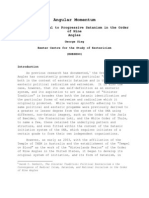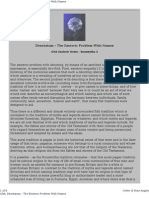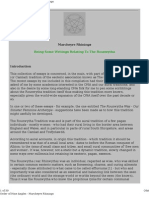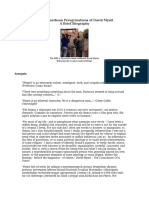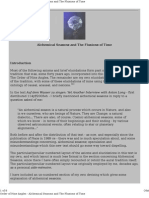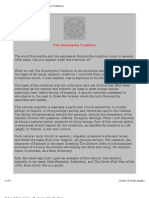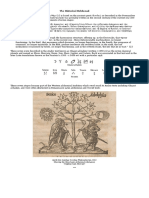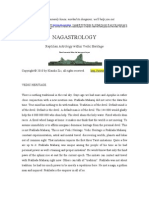Overview of The Star Game
Overview of The Star Game
Uploaded by
Dark JaperCopyright:
Available Formats
Overview of The Star Game
Overview of The Star Game
Uploaded by
Dark JaperCopyright
Available Formats
Share this document
Did you find this document useful?
Is this content inappropriate?
Copyright:
Available Formats
Overview of The Star Game
Overview of The Star Game
Uploaded by
Dark JaperCopyright:
Available Formats
Overview of the Myattian Star Game
Overview of The Star Game The Star Game is a three-dimensional board game [1] for two players [2] invented by David Myatt in 1975 [3][4] and subsequently used by the esoteric group the Order of Nine Angles (ONA) as occult sorcery [5][6] and as a three-dimensional representation of their occult system of septenary correspondences [5][7]. Each occult initiate is expected to make their own boards and pieces as a part of their occult training. The game was rst publicly outlined in the 1989 ONA text Naos: A Practical Guide to Modern Magick [8]. Boards, Pieces, and Gameplay There are two versions of the game, the simple and the advanced, with skill in the advanced form being a requirement for advancement to the ONA grade of Internal Adept [4]. When constructed, the advanced form of The Star Game is a large physical structure, usually six or more feet in height and three or more feet in width. The simple game has seven boards placed one above the other in a spiral, with the boards named after particular stars. Each board has nine black and nine white squares, making 126 squares in total over the seven boards. Each player (white and black) starts the game with three sets of nine pieces (27 pieces per player) with each piece allowed to move across a board, and up or down from board to board, in a dierent way. Only some types of pieces can capture other opposing pieces, and a captured piece is removed from the boards and plays no further part in the game. The seven boards are named Naos, Deneb, Rigel, Mira, Antares, Arcturus, and Sirius. At the start of the game, each player has six particular pieces on Sirius, three pieces on Arcturus, six pieces on Antares, three on Rigel, six on Deneb, three on Naos, and none on Mira. As in other board games, the players take turns to make their moves. The basic rule of play is that after a piece has been moved whether across a board or from one board to a higher or lower board it is transformed into another piece according to a set sequence and then can be moved according to its new designation. Another rule is that pieces can only stay on the Mira board for three moves.
Overview of the Myattian Star Game
The basic aim of the simple form of the game is for one player to place three of their pieces on certain squares on Mira, with the type of these pieces and their placing on that board decided by both players beforehand. The rst player to do this wins the game. This takes some skill and some time since not only can an opposing player capture pieces on Mira but also pieces are only allowed to stay on Mira for three moves, after which the player must move the piece. Depending on the skill of the player, to win a simple game takes from a few hours to a day or more. In the advanced Game, each board has six (minor) boards (three at each end), with there being additional pieces (more sets of nine for each player making 81 pieces per player). There are also additional rules regarding movement. In this version of The Star Game, each board is divided into three other levels so that there are four levels to each board, making a total of 308 squares over the seven main boards. Depending on the skill of the player, to win an advanced game can take several days. In both the simple and the advanced games, the pieces are usually small tetrahedrons (or small cubes) marked with the particular abstract symbol (or the particular occult symbol) which is used to designate that type of piece. There are two ways or methods of marking the pieces with the appropriate symbols. The rst way is to have a piece for each symbol, with the symbol painted or otherwise marked on the piece. This means making sucient extra (spare) pieces to enable the pieces in play to be changed when they are moved and become transformed into another piece. For example, when an () piece is moved it would be swapped for a spare () which in turn would be swapped for a spare () piece, and so on.
The second way is to paint or otherwise mark the face of the cube or the tetrahedron with dierent symbols in sequence. Thus, on the six faces of one cube there would be one piece with its faces/sides marked () () () () () (). In use, the symbol on the top of the cube - for example () - is the 'active' symbol, and designates the type of piece. When this () piece is moved, it becomes () so the cube is turned so that the () symbol is at the top. On its next move, this () piece would be transformed into () and the cube turned again so that the () symbol was at the top. This method of marking pieces also means that each player has to make extra (spare) pieces, although not as many as are required by the rst method.
References 1. James R. Lewis & Jasper Aagaard Petersen: The Encyclopedic Sourcebook of Satanism, Prometheus Books, 2008. p.625. ISBN 9781591023906 2. Jerey Kaplan & Tore Bjrgo: Nation and Race: The Developing Euro-American Racist Subculture. Northeastern University Press, 1998. p.116 ISBN 9781555533328
Overview of the Myattian Star Game
3. http://lapisphilosophicus.wordpress.com/star-game-history-and-theory/ [Accessed 2013-02-02] 4. Nicholas Goodrick-Clarke: Black Sun: Aryan Cults, Esoteric Nazism, and the Politics of Identity. New York University Press, 2003. p.219. ISBN 9780814731550 5. Senholt, Jacob. Secret Identities in The Sinister Tradition: Political Esotericism and the Convergence of Radical Islam, Satanism and National Socialism in the Order of Nine Angles, in Per Faxneld & Jesper Petersen (eds): The Devils Party: Satanism in Modernity, Oxford University Press (2012), p.260. ISBN 9780199779246 6. Jerey Kaplan (editor): Encyclopedia of White Power: A Sourcebook on the Radical Racist Right. AltaMira Press, 2000. p.236. ISBN 9780742503403 7. The septenary system of occult correspondences is unique to the Order of Nine Angles, and is represented by a Tree of Wyrd containing seven spheres (seven nexions) named after the fashion of early Arabic astrological and alchemical texts from the Middle East and North Africa Moon, Venus, Mercury, the Sun, Mars, Jupiter, and Saturn. The whole septenary system is regarded as a symbolic (or archetypal) map of both the world of the unconscious mind of the sorcerer/sorceress and the world of the supernatural, with the ONAs seven fold way the progress of the initiate through the seven occult grades or stages being regarded as a practical guide to attaining knowledge of both these worlds, a knowledge that enables the sorcerer/sorceress to undertake successful works of External, Internal, and Aeonic, sorcery/magick. The ONAs complete system of occult training and methods of practical sorcery including The Star Game are given in detail in their 981 page text The Requisite ONA, available in pdf format (as of January 2013) at http://lapisphilosophicus.les.wordpress.com/2012/07/the-requisite-ona.pdf (pdf 49 Mbytes) 8. A facsimile (in pdf format) of Naos as issued by the ONA in 1989 is available (as of January 2013) at http://lapisphilosophicus.les.wordpress.com/2012/08/naospractical-guide-to-modern-magick.pdf (pdf 43 Mbytes)
9
Further reading: http://regardingdavidmyatt.wordpress.com/2013/02/08/emanations-of-urania /Emanations of Urania
You might also like
- Angular Momentum - From Traditional To Progressive SatanismDocument16 pagesAngular Momentum - From Traditional To Progressive SatanismBarry SpottsNo ratings yet
- DocumentDocument39 pagesDocumentadficioNo ratings yet
- The Seven OxoniansDocument50 pagesThe Seven OxoniansKerri ScottNo ratings yet
- O9a Feond v1Document110 pagesO9a Feond v1qwertyuiop100% (1)
- Math Games & Activities from Around the WorldFrom EverandMath Games & Activities from Around the WorldRating: 4 out of 5 stars4/5 (4)
- Omega9Alpha: EpistemeDocument87 pagesOmega9Alpha: EpistemeMorena KapirisNo ratings yet
- Yogini DashaDocument2 pagesYogini DashaLeo Jones67% (3)
- The Star Game and The HebdomadDocument7 pagesThe Star Game and The HebdomadDark JaperNo ratings yet
- The Star Game Archive Part 1Document33 pagesThe Star Game Archive Part 1Dark Japer50% (2)
- The Star Game Archive Part 2Document6 pagesThe Star Game Archive Part 2Dark Japer50% (2)
- The Star GameDocument4 pagesThe Star Gamesliddell_380% (5)
- Some Advice For Neophytes Regarding The Order of Nine AnglesDocument9 pagesSome Advice For Neophytes Regarding The Order of Nine AnglesDark JaperNo ratings yet
- The Modern Myth of Myatt and LongDocument7 pagesThe Modern Myth of Myatt and LongDark Japer0% (1)
- Esoterikos - The Enigmatic TruthDocument6 pagesEsoterikos - The Enigmatic TruthDark Japer50% (2)
- O9A Aural TraditionDocument40 pagesO9A Aural TraditionDark Japer100% (1)
- The +o+ HandbookDocument138 pagesThe +o+ HandbookAtazothnashaasNo ratings yet
- Denotatum - Esoteric Rounwytha NotesDocument8 pagesDenotatum - Esoteric Rounwytha NotesDark Japer50% (2)
- O9a Reading ListDocument4 pagesO9a Reading Listrhode 12No ratings yet
- The Septenary, Crowley, and The Origins of The Order of Nine AnglesDocument5 pagesThe Septenary, Crowley, and The Origins of The Order of Nine AnglesDark Japer33% (3)
- Questions From A Modern RounwythaDocument7 pagesQuestions From A Modern RounwythaDark Japer100% (1)
- Rabbits and Razors - The Star Game LeagueDocument9 pagesRabbits and Razors - The Star Game Leaguenoctulius_moongod6002No ratings yet
- An Order of Nine Angles ParadoxDocument2 pagesAn Order of Nine Angles ParadoxDark JaperNo ratings yet
- The O9A Dark Art of ShrenchingDocument6 pagesThe O9A Dark Art of ShrenchingDwight Barrow100% (1)
- Marcheyre RhinningsDocument39 pagesMarcheyre RhinningsDark Japer0% (1)
- O9A: A Clear DistinctionDocument2 pagesO9A: A Clear DistinctionDark JaperNo ratings yet
- The Rounwytha WayDocument6 pagesThe Rounwytha WayDark Japer50% (2)
- Origins of The Septenary System of The Order of Nine AnglesDocument18 pagesOrigins of The Septenary System of The Order of Nine Anglessliddell_3100% (1)
- Guardians of The Anti-O9A NarrativeDocument9 pagesGuardians of The Anti-O9A NarrativeMyndianNo ratings yet
- Promethean Peregrinations of David MyattDocument27 pagesPromethean Peregrinations of David MyattDark JaperNo ratings yet
- From O9A To Hebdomian WayDocument5 pagesFrom O9A To Hebdomian WayDark Japer50% (2)
- Boundaries of Order of Nine Angles PhilosophyDocument14 pagesBoundaries of Order of Nine Angles PhilosophyDark Japer0% (1)
- More Anti-O9A Propaganda, Another Reasoned ResponseDocument8 pagesMore Anti-O9A Propaganda, Another Reasoned ResponseKerri ScottNo ratings yet
- Alchemical Seasons and Fluxions of TimeDocument8 pagesAlchemical Seasons and Fluxions of TimeDark Japer0% (1)
- David Myatt and The Quest For Lapis PhilosophicusDocument21 pagesDavid Myatt and The Quest For Lapis Philosophicussliddell_3No ratings yet
- Occult Fiction of The O9A - The TextsDocument670 pagesOccult Fiction of The O9A - The TextsDark Japer0% (1)
- Enantiodromia - The Sinister Abyssal NexionDocument14 pagesEnantiodromia - The Sinister Abyssal NexionDark Japer0% (1)
- Discovering Omega9AlphaDocument29 pagesDiscovering Omega9AlphaKerri ScottNo ratings yet
- The Rounwytha TraditionDocument7 pagesThe Rounwytha TraditionDark Japer100% (1)
- David Myatt: Diablerie and Bealuwes GastDocument16 pagesDavid Myatt: Diablerie and Bealuwes GastKerri ScottNo ratings yet
- VIII - Ga Wath Am - 0 PhysisDocument7 pagesVIII - Ga Wath Am - 0 PhysisAlice vythica100% (1)
- The O9A: Beyond Nihilism and AnarchismDocument13 pagesThe O9A: Beyond Nihilism and AnarchismBorja Rodríguez MelaraNo ratings yet
- Myatt and The O9ADocument9 pagesMyatt and The O9Asliddell_3No ratings yet
- The Sevenfold Seeking and Noesis of The Hebdomian WayDocument15 pagesThe Sevenfold Seeking and Noesis of The Hebdomian WayDark Japer100% (1)
- Discovering The Occult Phantom MenaceDocument29 pagesDiscovering The Occult Phantom MenaceMorena KapirisNo ratings yet
- Synopsis of The Numinous Way by David MyattDocument6 pagesSynopsis of The Numinous Way by David MyattDavid Myatt100% (1)
- Last Word On David MyattDocument2 pagesLast Word On David MyattThormyndNo ratings yet
- ONA - Sacramentum SinistrumDocument26 pagesONA - Sacramentum SinistrumJack VamorosNo ratings yet
- Notes On The Theory of The AcausalDocument5 pagesNotes On The Theory of The AcausalDark Japer100% (1)
- The Star Game 101Document17 pagesThe Star Game 101ThormyndNo ratings yet
- Satu Rank AmDocument2 pagesSatu Rank AmWkrscribdNo ratings yet
- CRPT Rulebook For WEB PDFDocument12 pagesCRPT Rulebook For WEB PDFteocelloNo ratings yet
- Report SubmissionDocument5 pagesReport SubmissionKarim Abdel Salam ElzahbyNo ratings yet
- Cosmic Encounter: The Complete Book ofDocument12 pagesCosmic Encounter: The Complete Book ofnicknack78No ratings yet
- 3 Man Chess in The RoundDocument10 pages3 Man Chess in The RoundNijahmidoriNo ratings yet
- Sunlight Rules Low InkDocument18 pagesSunlight Rules Low InkpetNo ratings yet
- Learning Mathematics Through GamesDocument3 pagesLearning Mathematics Through GamesAkayo BeyaNo ratings yet
- Animal Adaptations PlanDocument1 pageAnimal Adaptations Planapi-247247113No ratings yet
- Keltis Das OrakelDocument8 pagesKeltis Das OrakelAlinNo ratings yet
- Jazz Nights: The Card GameDocument15 pagesJazz Nights: The Card GameBURIN SINGTOAJNo ratings yet
- How To Play Solitaire For Beginners (With Pictures) - Set Up, How To WinDocument13 pagesHow To Play Solitaire For Beginners (With Pictures) - Set Up, How To WinashnfreemanNo ratings yet
- Seven Ages Collector Edition RulesDocument37 pagesSeven Ages Collector Edition RulesRaulonescribdNo ratings yet
- Dust Rulebook Epic EnigDocument24 pagesDust Rulebook Epic Enigfleabag8194No ratings yet
- David Myatt - Understanding and Rejecting ExtremismDocument57 pagesDavid Myatt - Understanding and Rejecting Extremismsliddell_3No ratings yet
- Countering The Prejudice of AntifascistsDocument84 pagesCountering The Prejudice of AntifascistsDark JaperNo ratings yet
- O9A: A Clear DistinctionDocument2 pagesO9A: A Clear DistinctionDark JaperNo ratings yet
- Wonder, Alterity, and The Immemorial As Devotional Candor in The ONADocument3 pagesWonder, Alterity, and The Immemorial As Devotional Candor in The ONADark JaperNo ratings yet
- The Sevenfold Seeking and Noesis of The Hebdomian WayDocument15 pagesThe Sevenfold Seeking and Noesis of The Hebdomian WayDark Japer100% (1)
- Author Profiling in The Case of David Myatt and Anton LongDocument5 pagesAuthor Profiling in The Case of David Myatt and Anton LongDark JaperNo ratings yet
- A Guide To O9A SubcultureDocument1,520 pagesA Guide To O9A SubcultureDark JaperNo ratings yet
- The Urban Tale of David Myatt and Anton LongDocument7 pagesThe Urban Tale of David Myatt and Anton LongDark Japer100% (1)
- The Order of Nine Angles (O9A) Side of The StoryDocument18 pagesThe Order of Nine Angles (O9A) Side of The StoryDark JaperNo ratings yet
- The Esoteric Philosophy and Seven Fold Way of Anton Long - A DebateDocument3 pagesThe Esoteric Philosophy and Seven Fold Way of Anton Long - A DebateDark JaperNo ratings yet
- David Myatt's Pymander and The HebdomadDocument3 pagesDavid Myatt's Pymander and The HebdomadDark JaperNo ratings yet
- The Trouble With David Myatt and The Order of Nine AnglesDocument15 pagesThe Trouble With David Myatt and The Order of Nine AnglesDark JaperNo ratings yet
- The Historical HebdomadDocument5 pagesThe Historical HebdomadDark JaperNo ratings yet
- An Order of Nine Angles ParadoxDocument2 pagesAn Order of Nine Angles ParadoxDark JaperNo ratings yet
- David Myatt and The Bigotry of AntifascistsDocument21 pagesDavid Myatt and The Bigotry of AntifascistsDark JaperNo ratings yet
- O9A - Discovering Nexion ZeroDocument80 pagesO9A - Discovering Nexion ZeroDark Japer50% (2)
- The Peregrinations of David Myatt: National Socialist IdeologistDocument46 pagesThe Peregrinations of David Myatt: National Socialist IdeologistDark Japer0% (1)
- Boundaries of Order of Nine Angles PhilosophyDocument14 pagesBoundaries of Order of Nine Angles PhilosophyDark Japer0% (1)
- Order of Nine Angles: Three Interviews With Anton LongDocument22 pagesOrder of Nine Angles: Three Interviews With Anton LongDark Japer50% (2)
- Beginners Guide To The Order of Nine AnglesDocument15 pagesBeginners Guide To The Order of Nine AnglesDark Japer0% (2)
- O9A: Aeonic Knowledge and Generational TransmissionDocument21 pagesO9A: Aeonic Knowledge and Generational TransmissionDark Japer0% (1)
- Laughing Along With Anton LongDocument5 pagesLaughing Along With Anton LongDark JaperNo ratings yet
- From O9A To Hebdomian WayDocument5 pagesFrom O9A To Hebdomian WayDark Japer50% (2)
- The Hebdomian WayDocument11 pagesThe Hebdomian WayDark Japer0% (1)
- The Modern Myth of Myatt and LongDocument7 pagesThe Modern Myth of Myatt and LongDark Japer0% (1)
- Truth About The Order of Nine AnglesDocument33 pagesTruth About The Order of Nine AnglesDark Japer0% (1)
- The Mystic Philosophy of David MyattDocument74 pagesThe Mystic Philosophy of David MyattKerri ScottNo ratings yet
- Seofonfeald Paeth TrilogyDocument301 pagesSeofonfeald Paeth TrilogyDark Japer0% (1)
- The Human AuraDocument37 pagesThe Human Aurasrinidhi1956No ratings yet
- Declamatio Fraternitatis EnglishDocument2 pagesDeclamatio Fraternitatis EnglishSincerus RenatusNo ratings yet
- Criminal Law and AstrologyDocument19 pagesCriminal Law and AstrologyAnahiti AtenaNo ratings yet
- Vedic Nadi Astrology For Career & Profession - Astrology & HoroscopeDocument2 pagesVedic Nadi Astrology For Career & Profession - Astrology & HoroscopeRakesh Soni100% (2)
- In Astrology, Which Planet Is Responsible For Skin Problems - QuoraDocument1 pageIn Astrology, Which Planet Is Responsible For Skin Problems - QuoraUtpal KumarNo ratings yet
- Kalam 38Document2 pagesKalam 38PremNo ratings yet
- Bardon Community PDFDocument1 pageBardon Community PDFarpitaNo ratings yet
- Tu Carta Astral Gratis, Astrologia Los Arcanos2Document8 pagesTu Carta Astral Gratis, Astrologia Los Arcanos2Ronald FrancisNo ratings yet
- K P Krishman S Astrology For Beginners Encyclopedia of Astrology Vol 4 PDFDocument170 pagesK P Krishman S Astrology For Beginners Encyclopedia of Astrology Vol 4 PDFPankaj Seeker100% (1)
- Lecture Note On Krishnamurti PaddhatiDocument6 pagesLecture Note On Krishnamurti Paddhatiiamkutty100% (1)
- Krishnamurthy Padhdhat by Sharad JoshiDocument95 pagesKrishnamurthy Padhdhat by Sharad JoshiSaravanan93% (15)
- Sigil (Magic) - WikipediaDocument2 pagesSigil (Magic) - WikipediaNyx Bella Dark100% (1)
- Fundamentals of Occultism: The Veil of The Form Occult StudyDocument2 pagesFundamentals of Occultism: The Veil of The Form Occult StudyStefaan Van NuffelNo ratings yet
- Witchcraft Spells How To Invoke The Witches or Divine Spirits PDFDocument2 pagesWitchcraft Spells How To Invoke The Witches or Divine Spirits PDFnitin rNo ratings yet
- Analysis On Varga ChartsDocument2 pagesAnalysis On Varga Chartsybbvvprasada raoNo ratings yet
- Astrology TarotDocument11 pagesAstrology Tarotขาบธัช ปัญจมะวัต100% (1)
- Reptilian Astrology For Prahlada MaharajDocument5 pagesReptilian Astrology For Prahlada MaharajNiyol RunakoNo ratings yet
- 98199-Article Text-188070-1-10-20210321Document14 pages98199-Article Text-188070-1-10-20210321roxanne FernandesNo ratings yet
- Sabian Aspect OrbsDocument8 pagesSabian Aspect Orbsellaella1375% (4)
- Icelandic Magic: The Mystery & Icelandic Magic: The Mystery & Power of The Galdrabok Power of The Galdrabok Grimoire GrimoireDocument2 pagesIcelandic Magic: The Mystery & Icelandic Magic: The Mystery & Power of The Galdrabok Power of The Galdrabok Grimoire Grimoiresubhanremo88No ratings yet
- Mangal DoshaDocument2 pagesMangal DoshaAdv. Govind S. Tehare100% (1)
- Astrology BasicsDocument3 pagesAstrology BasicsMohan Kumar100% (1)
- Remedies For Overcoming Obstacles in EducationDocument15 pagesRemedies For Overcoming Obstacles in EducationKALSHUBHNo ratings yet
- Zodiac SignsDocument7 pagesZodiac SignsSasikumarNo ratings yet
- Astrology 101 - Getting To Know Your Chart - Zodiac SignsDocument32 pagesAstrology 101 - Getting To Know Your Chart - Zodiac SignsBrandi Livelaughlove Jones100% (1)
- Exalted Planets in AstrologyDocument5 pagesExalted Planets in AstrologyKelvin PatelNo ratings yet
- The Ninth Arch by Kenneth GrantDocument2 pagesThe Ninth Arch by Kenneth GrantMogg Morgan100% (7)
- Short Report - Personal Portrait: Add A New Person Edit Data ForDocument5 pagesShort Report - Personal Portrait: Add A New Person Edit Data ForTina NikolacNo ratings yet
- Jyothisha Prakaasham Dhanus - VijayaDocument54 pagesJyothisha Prakaasham Dhanus - VijayaAnonymous 5mSMeP2jNo ratings yet
